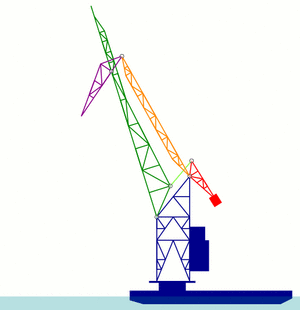Engineering:Jib (crane)
From HandWiki
Short description: Horizontal or near-horizontal beam used in many types of crane to support the load
A jib or jib arm is the horizontal or near-horizontal beam used in many types of crane to support the load clear of the main support.[1][2] An archaic spelling is gib.[3]
Usually jib arms are attached to a vertical mast or tower or sometimes to an inclined boom. In other jib-less designs such as derricks, the load is hung directly from a boom which is often anomalously called a jib.
A camera jib or jib arm in cinematography is a small crane that holds nothing but the camera.[4]
References
- ↑ James T. Frane Craftsman's Illustrated Dictionary of Construction Terms 1572180080 1994 p83 "crane jib -an extension at the top of a crane tower that gives the crane additional lifting or moving capabilities. There are different types of jibs. A saddle jib is a horizontal extension, at a right angle to the tower, with a hook attached to a trolley."
- ↑ Collins English Dictionary
- ↑ An Encyclopaedia of Civil Engineering, Edward Cresy (1847) "The gib of a crane should always revolve wholly round its axis, and be able to deliver the load at any point of the circle described by the axis of the gib"
- ↑ Scott Schaefermeyer Digital Video Basics 1418865133 2012 p109 "A jib arm is basically a small crane that holds nothing but the camera. Large jib arms require somebody to move and control the jib while the camera operator controls the camera. "
 |


